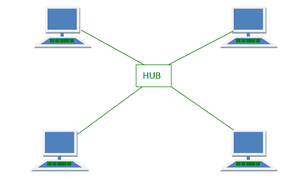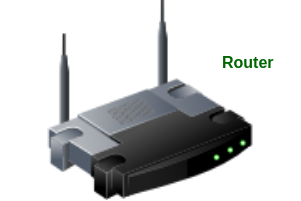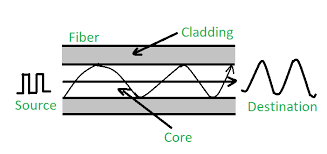Physical Components of Computer Network
Last Updated :
22 Jan, 2024
The hardware and software needed to set up computer networks at homes and businesses are referred to as computer network components. The server, client, peer, transmission media, and connecting devices make up the hardware components. The operating system and protocols are examples of software components. Basically, a computer network is made up of several computers connected to one another so that resources and data can be shared. Wireless or cable-based media are used to connect many PCs.
Types of Physical Components
A computer network consists of several physical components. In other words, two or more devices are connected via a computer network to exchange an almost infinite amount of data and services. Here Below are some physical components of computer Networks:
- NIC(Network Interface Card)
- HUB
- Router
- Modem
- Switch
- Nodes
- Media
- Repeater
- Server
1. NIC(Network Interface Card)
NIC or network interface card is a network adapter used to connect the computer to the network. It is installed in the computer to establish a LAN. It has a unique ID that is written on the chip, and it has a connector to connect the cable to it. The cable acts as an interface between the computer and the router or modem. NIC card is a layer 2 device, which means it works on the network model’s physical and data link layers.
Types of NIC
- Wired NIC: Cables and Connectors use Wired NIC to transfer data.
- Wireless NIC: These connect to a wireless network such as Wifi, Bluetooth, etc.
2. HUB
A HUB is a multi-port repeater. Hubs cannot filter data, so data packets are sent to all connected devices. In other words, the collision domain of all hosts connected through Hub remains one.
Types of HUB
- Repeatersuggests HUB: This is also known as Active HUB, it regenerates and amplifies the electric signal before sending them to all connected device. This hub is suitable to transmit data for long distance connections over the network.
- Passive HUB: As the name suggests it does not amplify or regenerate electric signal, it is the simplest types of Hub among all and it is not suitable for long-distnace connections.
- Switching HUB: This is also known as intelligent HUB, they provide some additional functionality over active and passive hubs. They analyze data packets and make decisions based on MAC address and they are operated on DLL(Data Link Layer).

Hub
3. Router
A Router is a device like a switch that routes data packets based on their IP addresses. The router is mainly a Network Layer device. Routers normally connect LANs and WANs and have a dynamically updating routing table based on which they make decisions on routing the data packets. The router divides the broadcast domains of hosts connected through it.
Types of Router
There are several types of routers available in the market, Some of them are mentioned in the given link: Types of Routers

4. Modem
A Modem is a short form of Modulator/Demodulator. The Modem is a hardware component/device that can connect computers and other devices such as routers and switches to the internet. Modems convert or modulate the analog signals coming from telephone wire into a digital form that is in the form of 0s and 1s.
Types of Modem
There are multiple types of Modem available you can visit the page where you find Types of Modems
5. Switch
A Switch is a multiport bridge with a buffer and a design that can boost its efficiency(a large number of ports implies less traffic) and performance. A switch is a data link layer device. The switch can perform error checking before forwarding data, which makes it very efficient as it does not forward packets that have errors and forward good packets selectively to the correct port only.
.gif)
Switches
Types of Switch
There are different types of switches in computer networks, visit the webpage and learn how many Types of Switches are there.
6. Nodes
Node is a term used to refer to any computing devices such as computers that send and receive network packets across the network.
Types of nodes
- End Nodes: These types of nodes are going to be the starting point or the end point of communication. E.g., computers, security cameras, network printers, etc.
- Intermediary Nodes: These nodes are going to be in between the starting point or end point of the end nodes. E.g., Switches, Bridges, Routers, cell towers, etc.
7. Media
It is also known as Link which is going to carry data from one side to another side. This link can be Wired Medium (Guided Medium) and Wireless Medium (Unguided Medium). It is of two types:
- Wired Media
- Wireless Media
Examples of Wired media are as follows:
Ethernet: Ethernet is the most widely used LAN technology, which is defined under IEEE standards 802.3. There are two types of Ethernet:
- Ethernet straight-through cable (used for two different devices).
- Ethernet crossover cable (used for two same devices).
Fibre Optic Cable: In this data is transferred in the form of light waves.

Optic Fibre Cable
Coaxial Cable: Mainly used for audio and video communications.

Coaxial Cable
USB Cable: USB Stands for Universal Serial Bus. Mainly used to connect PCs and smartphones.
.png)
USB
Examples of Wireless media are as follows:
- Infrared (E.g. short-range communication – TV remote control).
- Radio (E.g. Bluetooth, Wi-Fi).
- Microwaves (E.g. Cellular system).
- Satellite (E.g. Long range communications – GPS).
8. Repeater
Repeater is an important component of computer networks as it is used to regenerate and amplify signal in the computer networks. Repeaters are used to improve the quality of the networks and they are operated on the Physical Layer of the OSI Model.
Types of Repeaters
There are several types of repeaters based on specifications you can check by tapping the link Types of Repeaters.
9. Server
A server is a computer program that provides various functionality to another computer program. The server plays a vital role in facilitating communication, data storage, etc. Servers have more data storage as compared to normal computers. They are designed for the specific purpose of handling multiple requests from clients.
Types of Server
There are different types of servers in computer networks, visit the page and tap on the link to study Types of Servers.
Conclusion
The conclusion is, that each component of a computer network play a significant role in the efficient transmission of data which includes hardware, software devices, and network protocols. Hardware devices are the physical components of computer networks including NIC, HUB, etc and software are the programs that run on hardware devices, and the protocols are the set of rules that define how data is received and transmitted over the internet.
Frequently Asked Questions on Physical Components of Computer Networks – FAQs
What is a Gateway?
Gateway is the device used to connect two different networks and it is used to translate protocols to enable transmission between them.
What is a network cable?
Network cable is conect devices on the internet, there are three types of cabel available Twisted Pair Cable , Coaxial Cable , Optical Fiber Cable.
What is a firewall?
It is a network security device that provide protection from outside cyber attack by defending your computers from malicious softwares.
What is a protocol in Computer Networks?
A protocol is a set of rules that defines how data is transmitted and recieved over the internet, they also helps to make communication effective.
What is Computer Network components?
Computer Network Components are the parts which are necesarry to install a software which include various components like NIC , Router , Modem , HUB , Switch etc.
Like Article
Suggest improvement
Share your thoughts in the comments
Please Login to comment...